UMED8A-15-1: Global Oil Industry and Market Analysis from 2008-2018
VerifiedAdded on 2023/06/03
|8
|2409
|100
Essay
AI Summary
This essay provides a comprehensive analysis of the global oil market and industry from 2008 to 2018. It examines the factors influencing oil prices, including changes in supply and demand, economic recessions, and geopolitical events. The essay discusses the impact of the Great Recession in 2008, the oil price collapse in 2014-2016, and the surge in oil prices in 2011. It also addresses the role of OPEC, the rise of U.S. oil production, and the increasing demand from developing nations like China and India. Furthermore, the essay explores the concept of elasticity in the oil market, focusing on how changes in price affect supply and demand, and considers the potential impact of electric vehicles and energy-efficient technologies on future oil demand. The analysis incorporates various sources and references to support its arguments, providing a thorough overview of the dynamics within the global oil market during this period.
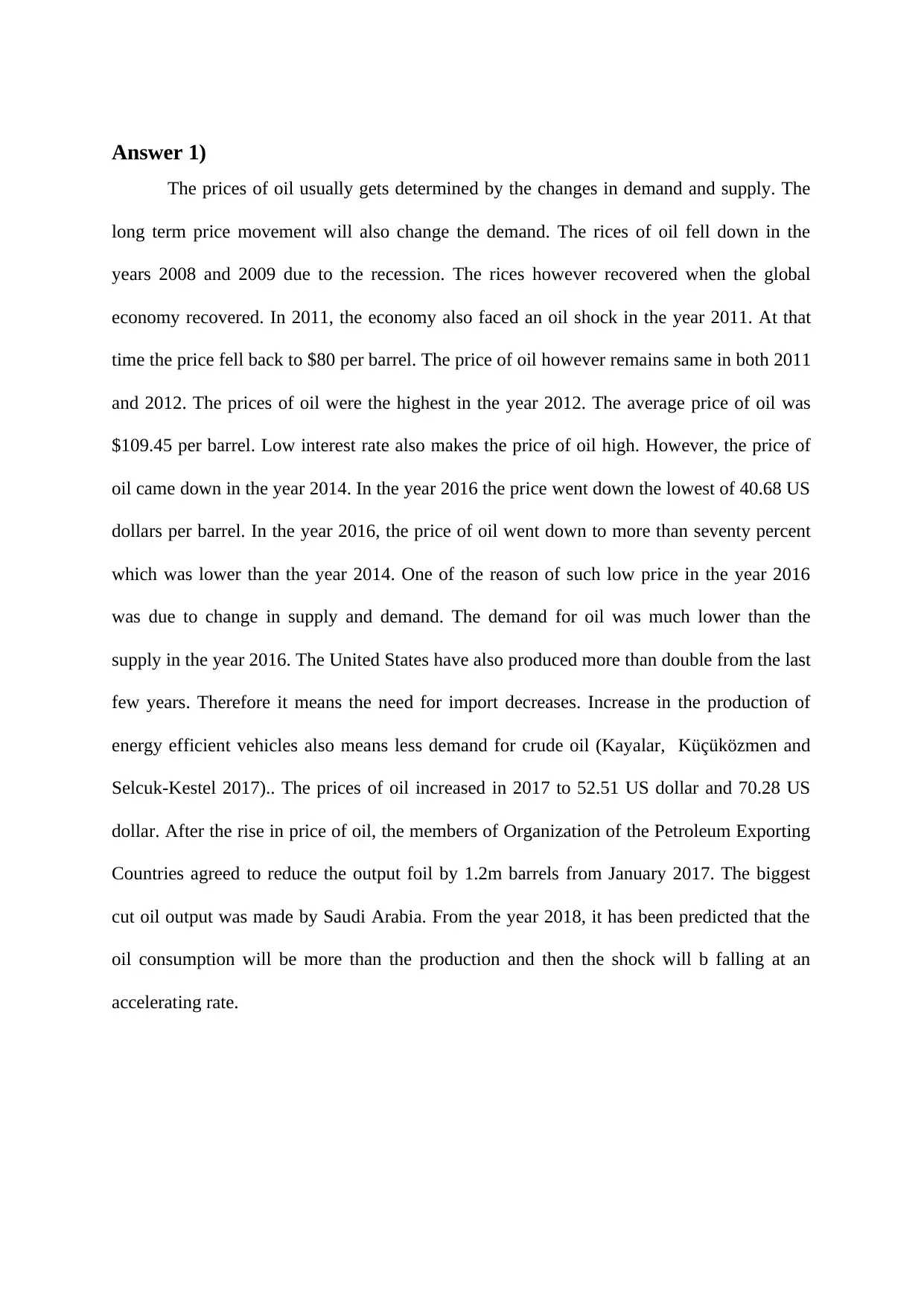
Answer 1)
The prices of oil usually gets determined by the changes in demand and supply. The
long term price movement will also change the demand. The rices of oil fell down in the
years 2008 and 2009 due to the recession. The rices however recovered when the global
economy recovered. In 2011, the economy also faced an oil shock in the year 2011. At that
time the price fell back to $80 per barrel. The price of oil however remains same in both 2011
and 2012. The prices of oil were the highest in the year 2012. The average price of oil was
$109.45 per barrel. Low interest rate also makes the price of oil high. However, the price of
oil came down in the year 2014. In the year 2016 the price went down the lowest of 40.68 US
dollars per barrel. In the year 2016, the price of oil went down to more than seventy percent
which was lower than the year 2014. One of the reason of such low price in the year 2016
was due to change in supply and demand. The demand for oil was much lower than the
supply in the year 2016. The United States have also produced more than double from the last
few years. Therefore it means the need for import decreases. Increase in the production of
energy efficient vehicles also means less demand for crude oil (Kayalar, Küçüközmen and
Selcuk-Kestel 2017).. The prices of oil increased in 2017 to 52.51 US dollar and 70.28 US
dollar. After the rise in price of oil, the members of Organization of the Petroleum Exporting
Countries agreed to reduce the output foil by 1.2m barrels from January 2017. The biggest
cut oil output was made by Saudi Arabia. From the year 2018, it has been predicted that the
oil consumption will be more than the production and then the shock will b falling at an
accelerating rate.
The prices of oil usually gets determined by the changes in demand and supply. The
long term price movement will also change the demand. The rices of oil fell down in the
years 2008 and 2009 due to the recession. The rices however recovered when the global
economy recovered. In 2011, the economy also faced an oil shock in the year 2011. At that
time the price fell back to $80 per barrel. The price of oil however remains same in both 2011
and 2012. The prices of oil were the highest in the year 2012. The average price of oil was
$109.45 per barrel. Low interest rate also makes the price of oil high. However, the price of
oil came down in the year 2014. In the year 2016 the price went down the lowest of 40.68 US
dollars per barrel. In the year 2016, the price of oil went down to more than seventy percent
which was lower than the year 2014. One of the reason of such low price in the year 2016
was due to change in supply and demand. The demand for oil was much lower than the
supply in the year 2016. The United States have also produced more than double from the last
few years. Therefore it means the need for import decreases. Increase in the production of
energy efficient vehicles also means less demand for crude oil (Kayalar, Küçüközmen and
Selcuk-Kestel 2017).. The prices of oil increased in 2017 to 52.51 US dollar and 70.28 US
dollar. After the rise in price of oil, the members of Organization of the Petroleum Exporting
Countries agreed to reduce the output foil by 1.2m barrels from January 2017. The biggest
cut oil output was made by Saudi Arabia. From the year 2018, it has been predicted that the
oil consumption will be more than the production and then the shock will b falling at an
accelerating rate.
Paraphrase This Document
Need a fresh take? Get an instant paraphrase of this document with our AI Paraphraser
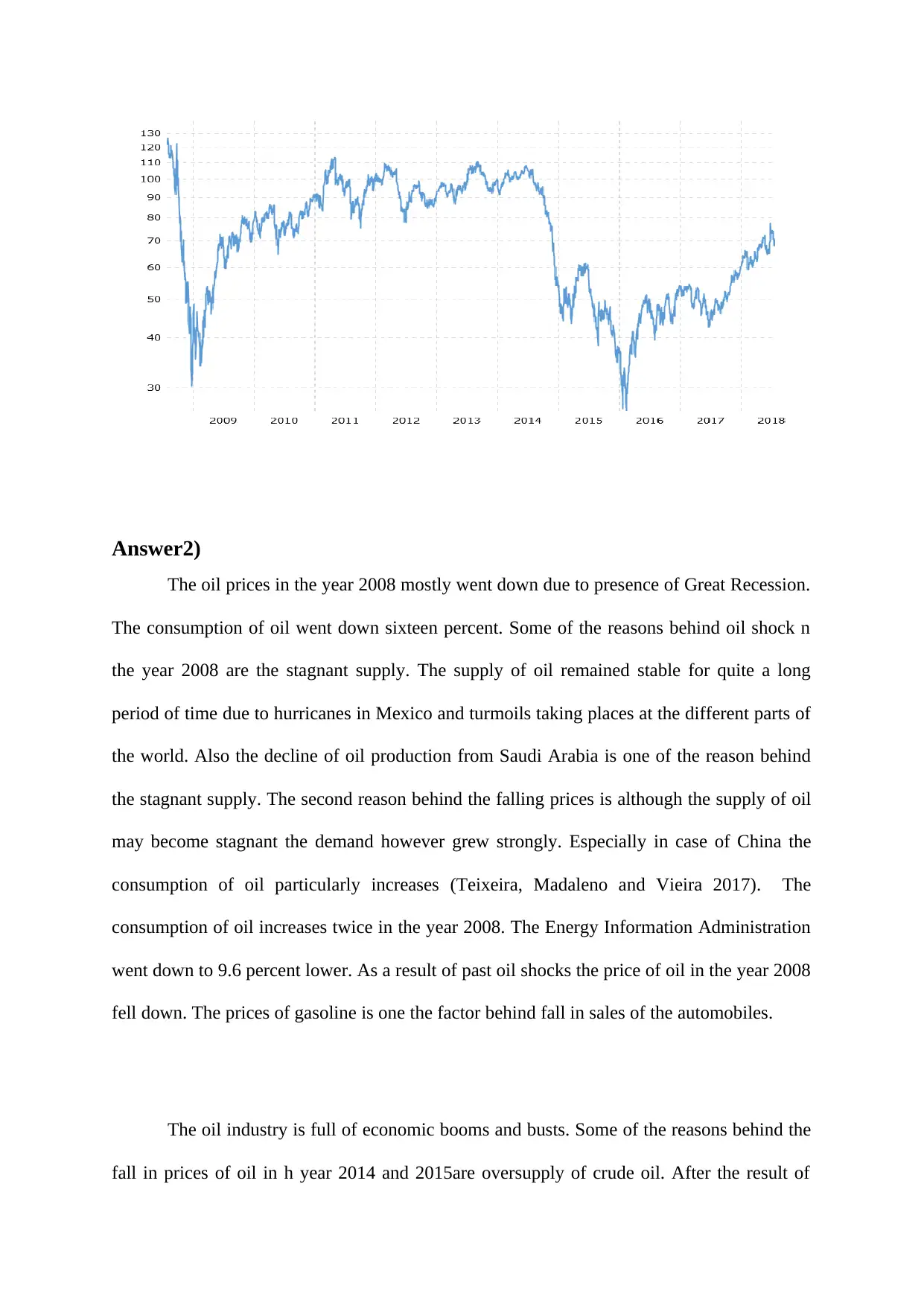
Answer2)
The oil prices in the year 2008 mostly went down due to presence of Great Recession.
The consumption of oil went down sixteen percent. Some of the reasons behind oil shock n
the year 2008 are the stagnant supply. The supply of oil remained stable for quite a long
period of time due to hurricanes in Mexico and turmoils taking places at the different parts of
the world. Also the decline of oil production from Saudi Arabia is one of the reason behind
the stagnant supply. The second reason behind the falling prices is although the supply of oil
may become stagnant the demand however grew strongly. Especially in case of China the
consumption of oil particularly increases (Teixeira, Madaleno and Vieira 2017). The
consumption of oil increases twice in the year 2008. The Energy Information Administration
went down to 9.6 percent lower. As a result of past oil shocks the price of oil in the year 2008
fell down. The prices of gasoline is one the factor behind fall in sales of the automobiles.
The oil industry is full of economic booms and busts. Some of the reasons behind the
fall in prices of oil in h year 2014 and 2015are oversupply of crude oil. After the result of
The oil prices in the year 2008 mostly went down due to presence of Great Recession.
The consumption of oil went down sixteen percent. Some of the reasons behind oil shock n
the year 2008 are the stagnant supply. The supply of oil remained stable for quite a long
period of time due to hurricanes in Mexico and turmoils taking places at the different parts of
the world. Also the decline of oil production from Saudi Arabia is one of the reason behind
the stagnant supply. The second reason behind the falling prices is although the supply of oil
may become stagnant the demand however grew strongly. Especially in case of China the
consumption of oil particularly increases (Teixeira, Madaleno and Vieira 2017). The
consumption of oil increases twice in the year 2008. The Energy Information Administration
went down to 9.6 percent lower. As a result of past oil shocks the price of oil in the year 2008
fell down. The prices of gasoline is one the factor behind fall in sales of the automobiles.
The oil industry is full of economic booms and busts. Some of the reasons behind the
fall in prices of oil in h year 2014 and 2015are oversupply of crude oil. After the result of
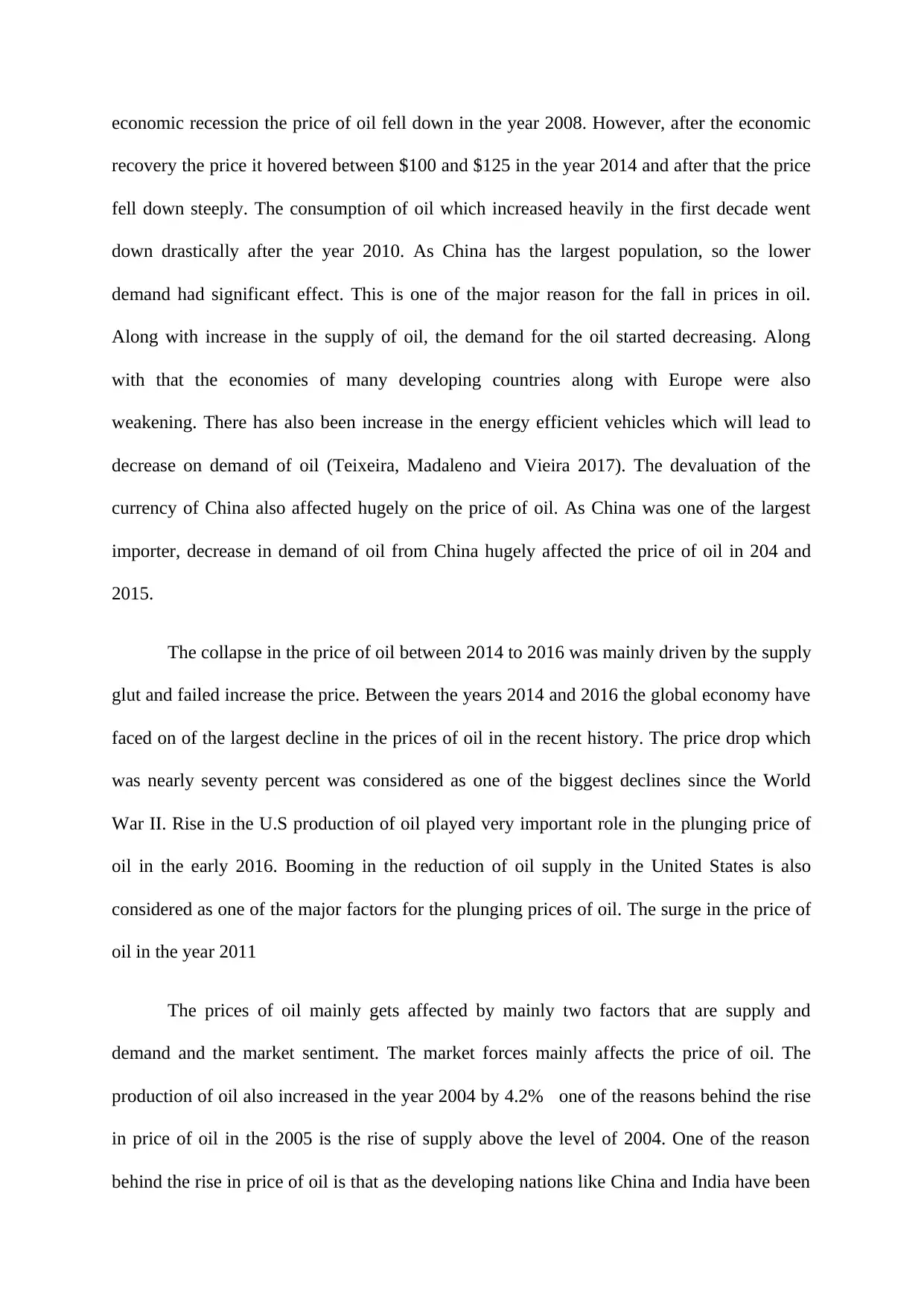
economic recession the price of oil fell down in the year 2008. However, after the economic
recovery the price it hovered between $100 and $125 in the year 2014 and after that the price
fell down steeply. The consumption of oil which increased heavily in the first decade went
down drastically after the year 2010. As China has the largest population, so the lower
demand had significant effect. This is one of the major reason for the fall in prices in oil.
Along with increase in the supply of oil, the demand for the oil started decreasing. Along
with that the economies of many developing countries along with Europe were also
weakening. There has also been increase in the energy efficient vehicles which will lead to
decrease on demand of oil (Teixeira, Madaleno and Vieira 2017). The devaluation of the
currency of China also affected hugely on the price of oil. As China was one of the largest
importer, decrease in demand of oil from China hugely affected the price of oil in 204 and
2015.
The collapse in the price of oil between 2014 to 2016 was mainly driven by the supply
glut and failed increase the price. Between the years 2014 and 2016 the global economy have
faced on of the largest decline in the prices of oil in the recent history. The price drop which
was nearly seventy percent was considered as one of the biggest declines since the World
War II. Rise in the U.S production of oil played very important role in the plunging price of
oil in the early 2016. Booming in the reduction of oil supply in the United States is also
considered as one of the major factors for the plunging prices of oil. The surge in the price of
oil in the year 2011
The prices of oil mainly gets affected by mainly two factors that are supply and
demand and the market sentiment. The market forces mainly affects the price of oil. The
production of oil also increased in the year 2004 by 4.2% one of the reasons behind the rise
in price of oil in the 2005 is the rise of supply above the level of 2004. One of the reason
behind the rise in price of oil is that as the developing nations like China and India have been
recovery the price it hovered between $100 and $125 in the year 2014 and after that the price
fell down steeply. The consumption of oil which increased heavily in the first decade went
down drastically after the year 2010. As China has the largest population, so the lower
demand had significant effect. This is one of the major reason for the fall in prices in oil.
Along with increase in the supply of oil, the demand for the oil started decreasing. Along
with that the economies of many developing countries along with Europe were also
weakening. There has also been increase in the energy efficient vehicles which will lead to
decrease on demand of oil (Teixeira, Madaleno and Vieira 2017). The devaluation of the
currency of China also affected hugely on the price of oil. As China was one of the largest
importer, decrease in demand of oil from China hugely affected the price of oil in 204 and
2015.
The collapse in the price of oil between 2014 to 2016 was mainly driven by the supply
glut and failed increase the price. Between the years 2014 and 2016 the global economy have
faced on of the largest decline in the prices of oil in the recent history. The price drop which
was nearly seventy percent was considered as one of the biggest declines since the World
War II. Rise in the U.S production of oil played very important role in the plunging price of
oil in the early 2016. Booming in the reduction of oil supply in the United States is also
considered as one of the major factors for the plunging prices of oil. The surge in the price of
oil in the year 2011
The prices of oil mainly gets affected by mainly two factors that are supply and
demand and the market sentiment. The market forces mainly affects the price of oil. The
production of oil also increased in the year 2004 by 4.2% one of the reasons behind the rise
in price of oil in the 2005 is the rise of supply above the level of 2004. One of the reason
behind the rise in price of oil is that as the developing nations like China and India have been
⊘ This is a preview!⊘
Do you want full access?
Subscribe today to unlock all pages.

Trusted by 1+ million students worldwide
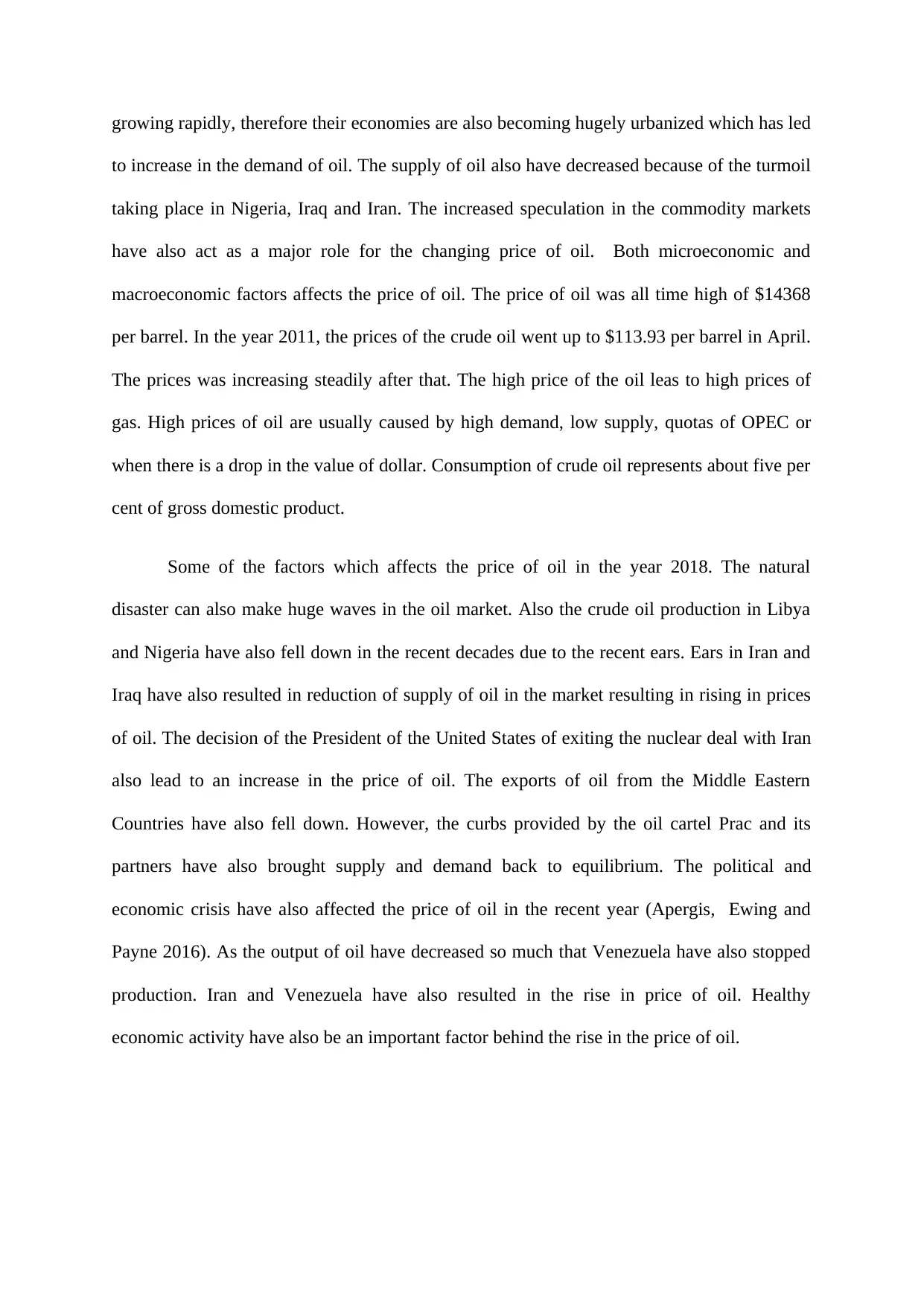
growing rapidly, therefore their economies are also becoming hugely urbanized which has led
to increase in the demand of oil. The supply of oil also have decreased because of the turmoil
taking place in Nigeria, Iraq and Iran. The increased speculation in the commodity markets
have also act as a major role for the changing price of oil. Both microeconomic and
macroeconomic factors affects the price of oil. The price of oil was all time high of $14368
per barrel. In the year 2011, the prices of the crude oil went up to $113.93 per barrel in April.
The prices was increasing steadily after that. The high price of the oil leas to high prices of
gas. High prices of oil are usually caused by high demand, low supply, quotas of OPEC or
when there is a drop in the value of dollar. Consumption of crude oil represents about five per
cent of gross domestic product.
Some of the factors which affects the price of oil in the year 2018. The natural
disaster can also make huge waves in the oil market. Also the crude oil production in Libya
and Nigeria have also fell down in the recent decades due to the recent ears. Ears in Iran and
Iraq have also resulted in reduction of supply of oil in the market resulting in rising in prices
of oil. The decision of the President of the United States of exiting the nuclear deal with Iran
also lead to an increase in the price of oil. The exports of oil from the Middle Eastern
Countries have also fell down. However, the curbs provided by the oil cartel Prac and its
partners have also brought supply and demand back to equilibrium. The political and
economic crisis have also affected the price of oil in the recent year (Apergis, Ewing and
Payne 2016). As the output of oil have decreased so much that Venezuela have also stopped
production. Iran and Venezuela have also resulted in the rise in price of oil. Healthy
economic activity have also be an important factor behind the rise in the price of oil.
to increase in the demand of oil. The supply of oil also have decreased because of the turmoil
taking place in Nigeria, Iraq and Iran. The increased speculation in the commodity markets
have also act as a major role for the changing price of oil. Both microeconomic and
macroeconomic factors affects the price of oil. The price of oil was all time high of $14368
per barrel. In the year 2011, the prices of the crude oil went up to $113.93 per barrel in April.
The prices was increasing steadily after that. The high price of the oil leas to high prices of
gas. High prices of oil are usually caused by high demand, low supply, quotas of OPEC or
when there is a drop in the value of dollar. Consumption of crude oil represents about five per
cent of gross domestic product.
Some of the factors which affects the price of oil in the year 2018. The natural
disaster can also make huge waves in the oil market. Also the crude oil production in Libya
and Nigeria have also fell down in the recent decades due to the recent ears. Ears in Iran and
Iraq have also resulted in reduction of supply of oil in the market resulting in rising in prices
of oil. The decision of the President of the United States of exiting the nuclear deal with Iran
also lead to an increase in the price of oil. The exports of oil from the Middle Eastern
Countries have also fell down. However, the curbs provided by the oil cartel Prac and its
partners have also brought supply and demand back to equilibrium. The political and
economic crisis have also affected the price of oil in the recent year (Apergis, Ewing and
Payne 2016). As the output of oil have decreased so much that Venezuela have also stopped
production. Iran and Venezuela have also resulted in the rise in price of oil. Healthy
economic activity have also be an important factor behind the rise in the price of oil.
Paraphrase This Document
Need a fresh take? Get an instant paraphrase of this document with our AI Paraphraser
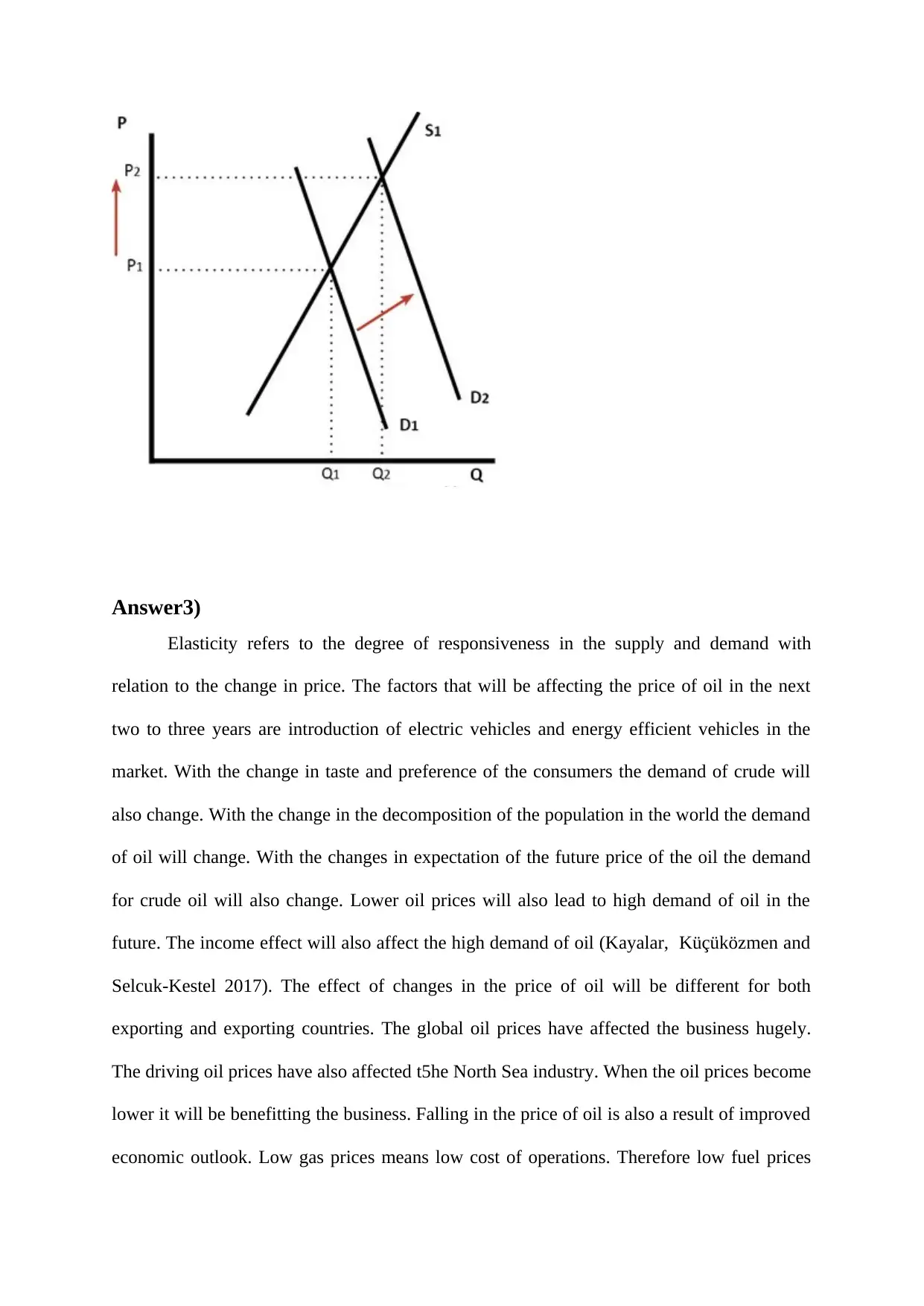
Answer3)
Elasticity refers to the degree of responsiveness in the supply and demand with
relation to the change in price. The factors that will be affecting the price of oil in the next
two to three years are introduction of electric vehicles and energy efficient vehicles in the
market. With the change in taste and preference of the consumers the demand of crude will
also change. With the change in the decomposition of the population in the world the demand
of oil will change. With the changes in expectation of the future price of the oil the demand
for crude oil will also change. Lower oil prices will also lead to high demand of oil in the
future. The income effect will also affect the high demand of oil (Kayalar, Küçüközmen and
Selcuk-Kestel 2017). The effect of changes in the price of oil will be different for both
exporting and exporting countries. The global oil prices have affected the business hugely.
The driving oil prices have also affected t5he North Sea industry. When the oil prices become
lower it will be benefitting the business. Falling in the price of oil is also a result of improved
economic outlook. Low gas prices means low cost of operations. Therefore low fuel prices
Elasticity refers to the degree of responsiveness in the supply and demand with
relation to the change in price. The factors that will be affecting the price of oil in the next
two to three years are introduction of electric vehicles and energy efficient vehicles in the
market. With the change in taste and preference of the consumers the demand of crude will
also change. With the change in the decomposition of the population in the world the demand
of oil will change. With the changes in expectation of the future price of the oil the demand
for crude oil will also change. Lower oil prices will also lead to high demand of oil in the
future. The income effect will also affect the high demand of oil (Kayalar, Küçüközmen and
Selcuk-Kestel 2017). The effect of changes in the price of oil will be different for both
exporting and exporting countries. The global oil prices have affected the business hugely.
The driving oil prices have also affected t5he North Sea industry. When the oil prices become
lower it will be benefitting the business. Falling in the price of oil is also a result of improved
economic outlook. Low gas prices means low cost of operations. Therefore low fuel prices
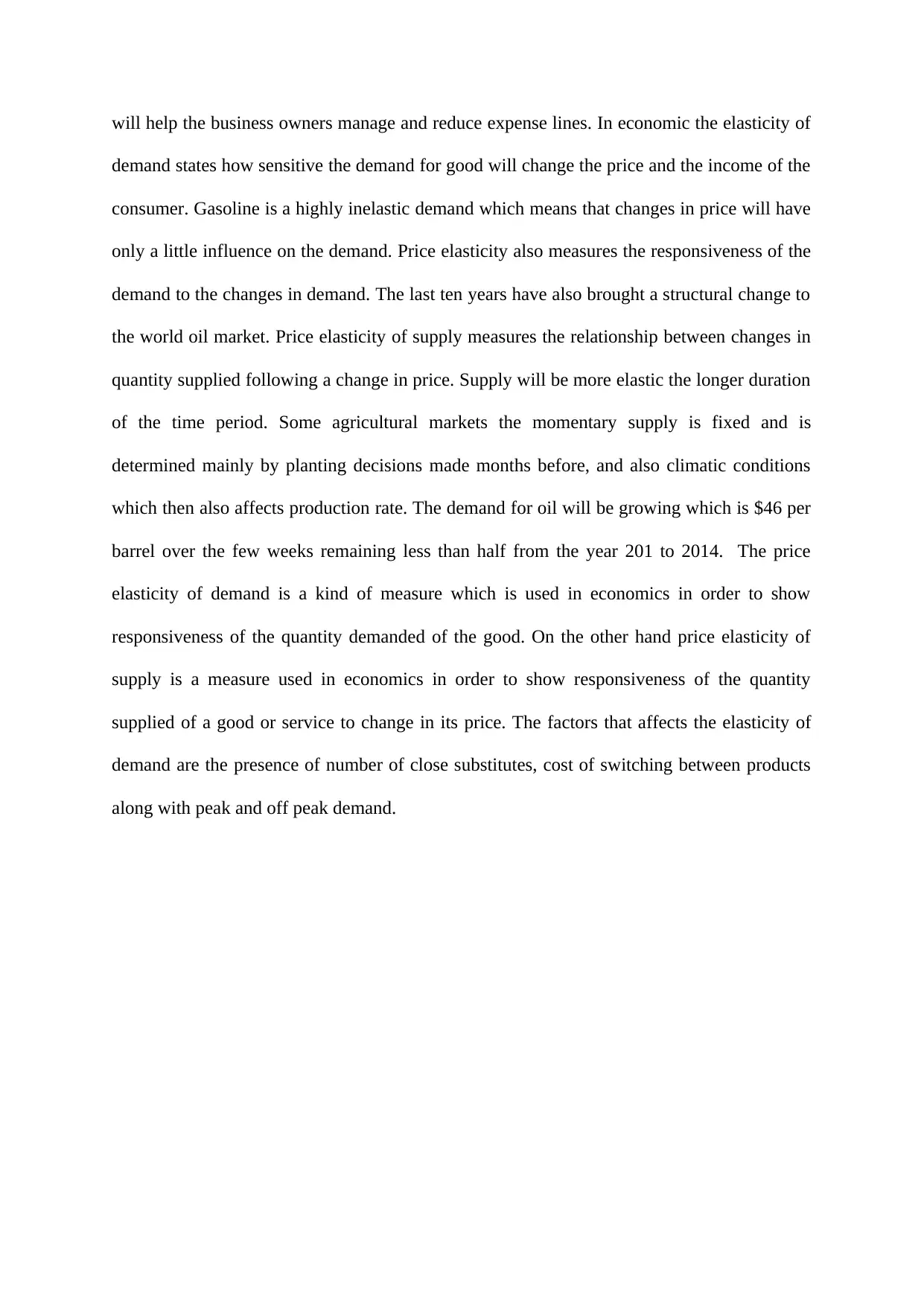
will help the business owners manage and reduce expense lines. In economic the elasticity of
demand states how sensitive the demand for good will change the price and the income of the
consumer. Gasoline is a highly inelastic demand which means that changes in price will have
only a little influence on the demand. Price elasticity also measures the responsiveness of the
demand to the changes in demand. The last ten years have also brought a structural change to
the world oil market. Price elasticity of supply measures the relationship between changes in
quantity supplied following a change in price. Supply will be more elastic the longer duration
of the time period. Some agricultural markets the momentary supply is fixed and is
determined mainly by planting decisions made months before, and also climatic conditions
which then also affects production rate. The demand for oil will be growing which is $46 per
barrel over the few weeks remaining less than half from the year 201 to 2014. The price
elasticity of demand is a kind of measure which is used in economics in order to show
responsiveness of the quantity demanded of the good. On the other hand price elasticity of
supply is a measure used in economics in order to show responsiveness of the quantity
supplied of a good or service to change in its price. The factors that affects the elasticity of
demand are the presence of number of close substitutes, cost of switching between products
along with peak and off peak demand.
demand states how sensitive the demand for good will change the price and the income of the
consumer. Gasoline is a highly inelastic demand which means that changes in price will have
only a little influence on the demand. Price elasticity also measures the responsiveness of the
demand to the changes in demand. The last ten years have also brought a structural change to
the world oil market. Price elasticity of supply measures the relationship between changes in
quantity supplied following a change in price. Supply will be more elastic the longer duration
of the time period. Some agricultural markets the momentary supply is fixed and is
determined mainly by planting decisions made months before, and also climatic conditions
which then also affects production rate. The demand for oil will be growing which is $46 per
barrel over the few weeks remaining less than half from the year 201 to 2014. The price
elasticity of demand is a kind of measure which is used in economics in order to show
responsiveness of the quantity demanded of the good. On the other hand price elasticity of
supply is a measure used in economics in order to show responsiveness of the quantity
supplied of a good or service to change in its price. The factors that affects the elasticity of
demand are the presence of number of close substitutes, cost of switching between products
along with peak and off peak demand.
⊘ This is a preview!⊘
Do you want full access?
Subscribe today to unlock all pages.

Trusted by 1+ million students worldwide
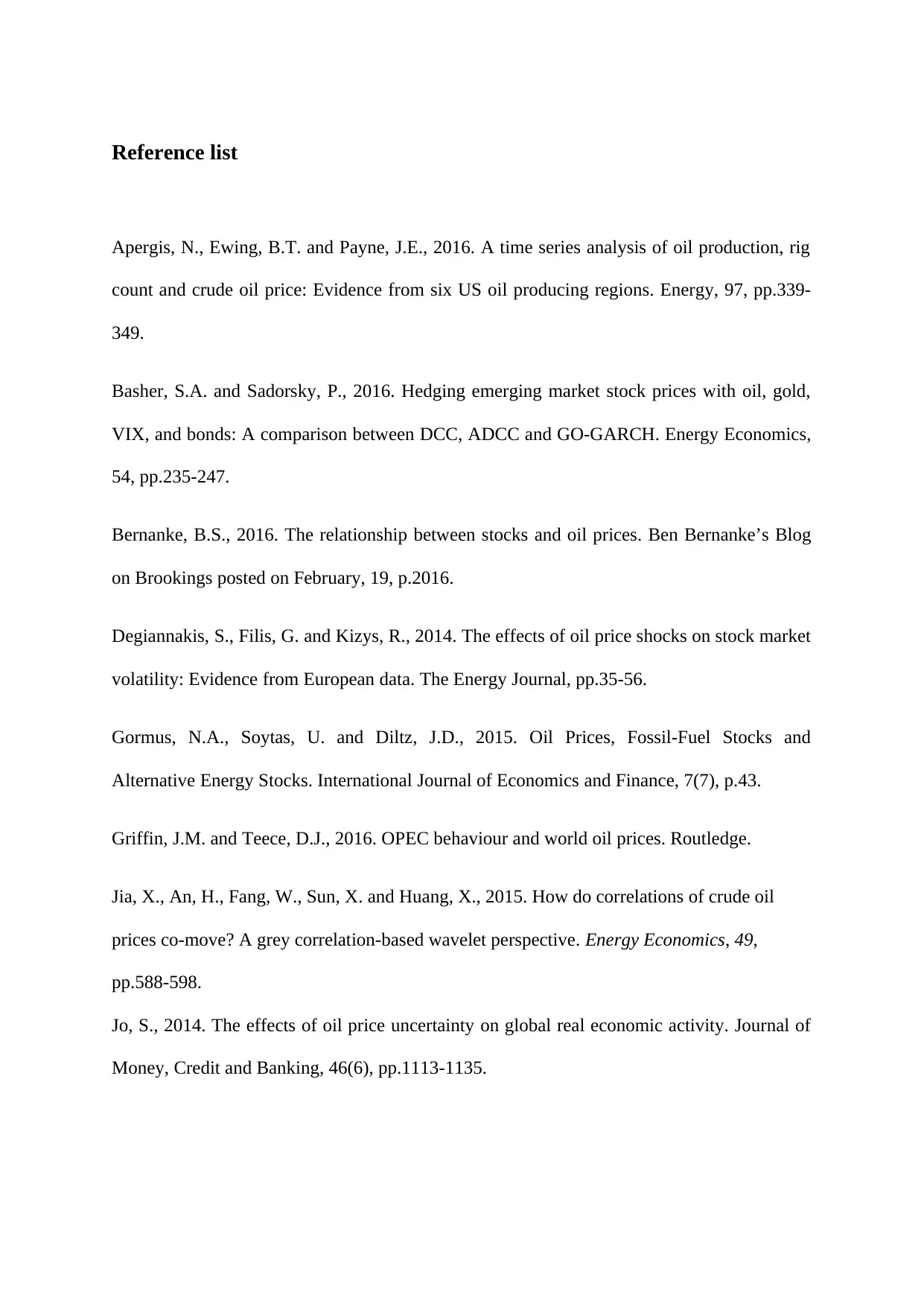
Reference list
Apergis, N., Ewing, B.T. and Payne, J.E., 2016. A time series analysis of oil production, rig
count and crude oil price: Evidence from six US oil producing regions. Energy, 97, pp.339-
349.
Basher, S.A. and Sadorsky, P., 2016. Hedging emerging market stock prices with oil, gold,
VIX, and bonds: A comparison between DCC, ADCC and GO-GARCH. Energy Economics,
54, pp.235-247.
Bernanke, B.S., 2016. The relationship between stocks and oil prices. Ben Bernanke’s Blog
on Brookings posted on February, 19, p.2016.
Degiannakis, S., Filis, G. and Kizys, R., 2014. The effects of oil price shocks on stock market
volatility: Evidence from European data. The Energy Journal, pp.35-56.
Gormus, N.A., Soytas, U. and Diltz, J.D., 2015. Oil Prices, Fossil-Fuel Stocks and
Alternative Energy Stocks. International Journal of Economics and Finance, 7(7), p.43.
Griffin, J.M. and Teece, D.J., 2016. OPEC behaviour and world oil prices. Routledge.
Jia, X., An, H., Fang, W., Sun, X. and Huang, X., 2015. How do correlations of crude oil
prices co-move? A grey correlation-based wavelet perspective. Energy Economics, 49,
pp.588-598.
Jo, S., 2014. The effects of oil price uncertainty on global real economic activity. Journal of
Money, Credit and Banking, 46(6), pp.1113-1135.
Apergis, N., Ewing, B.T. and Payne, J.E., 2016. A time series analysis of oil production, rig
count and crude oil price: Evidence from six US oil producing regions. Energy, 97, pp.339-
349.
Basher, S.A. and Sadorsky, P., 2016. Hedging emerging market stock prices with oil, gold,
VIX, and bonds: A comparison between DCC, ADCC and GO-GARCH. Energy Economics,
54, pp.235-247.
Bernanke, B.S., 2016. The relationship between stocks and oil prices. Ben Bernanke’s Blog
on Brookings posted on February, 19, p.2016.
Degiannakis, S., Filis, G. and Kizys, R., 2014. The effects of oil price shocks on stock market
volatility: Evidence from European data. The Energy Journal, pp.35-56.
Gormus, N.A., Soytas, U. and Diltz, J.D., 2015. Oil Prices, Fossil-Fuel Stocks and
Alternative Energy Stocks. International Journal of Economics and Finance, 7(7), p.43.
Griffin, J.M. and Teece, D.J., 2016. OPEC behaviour and world oil prices. Routledge.
Jia, X., An, H., Fang, W., Sun, X. and Huang, X., 2015. How do correlations of crude oil
prices co-move? A grey correlation-based wavelet perspective. Energy Economics, 49,
pp.588-598.
Jo, S., 2014. The effects of oil price uncertainty on global real economic activity. Journal of
Money, Credit and Banking, 46(6), pp.1113-1135.
Paraphrase This Document
Need a fresh take? Get an instant paraphrase of this document with our AI Paraphraser
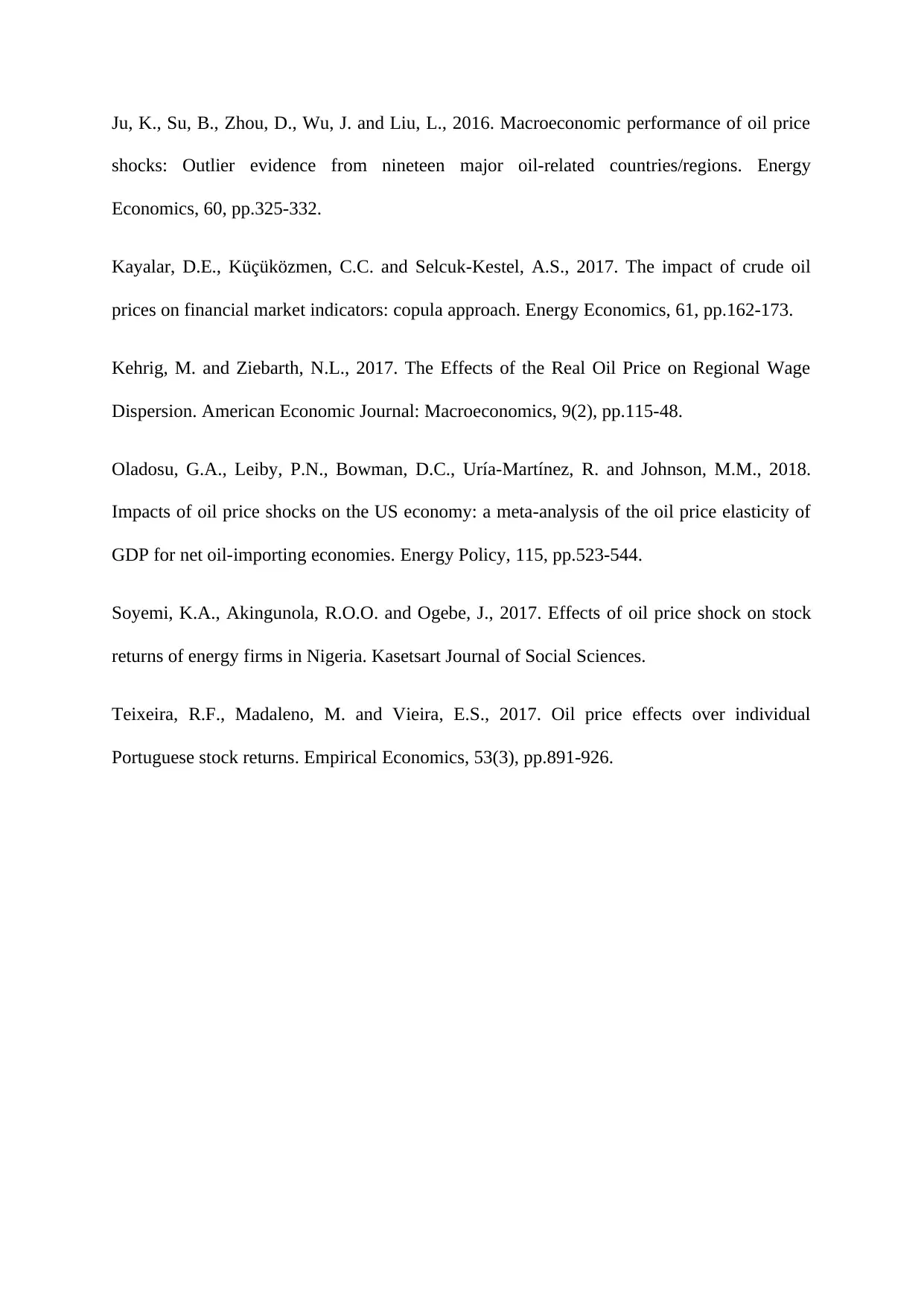
Ju, K., Su, B., Zhou, D., Wu, J. and Liu, L., 2016. Macroeconomic performance of oil price
shocks: Outlier evidence from nineteen major oil-related countries/regions. Energy
Economics, 60, pp.325-332.
Kayalar, D.E., Küçüközmen, C.C. and Selcuk-Kestel, A.S., 2017. The impact of crude oil
prices on financial market indicators: copula approach. Energy Economics, 61, pp.162-173.
Kehrig, M. and Ziebarth, N.L., 2017. The Effects of the Real Oil Price on Regional Wage
Dispersion. American Economic Journal: Macroeconomics, 9(2), pp.115-48.
Oladosu, G.A., Leiby, P.N., Bowman, D.C., Uría-Martínez, R. and Johnson, M.M., 2018.
Impacts of oil price shocks on the US economy: a meta-analysis of the oil price elasticity of
GDP for net oil-importing economies. Energy Policy, 115, pp.523-544.
Soyemi, K.A., Akingunola, R.O.O. and Ogebe, J., 2017. Effects of oil price shock on stock
returns of energy firms in Nigeria. Kasetsart Journal of Social Sciences.
Teixeira, R.F., Madaleno, M. and Vieira, E.S., 2017. Oil price effects over individual
Portuguese stock returns. Empirical Economics, 53(3), pp.891-926.
shocks: Outlier evidence from nineteen major oil-related countries/regions. Energy
Economics, 60, pp.325-332.
Kayalar, D.E., Küçüközmen, C.C. and Selcuk-Kestel, A.S., 2017. The impact of crude oil
prices on financial market indicators: copula approach. Energy Economics, 61, pp.162-173.
Kehrig, M. and Ziebarth, N.L., 2017. The Effects of the Real Oil Price on Regional Wage
Dispersion. American Economic Journal: Macroeconomics, 9(2), pp.115-48.
Oladosu, G.A., Leiby, P.N., Bowman, D.C., Uría-Martínez, R. and Johnson, M.M., 2018.
Impacts of oil price shocks on the US economy: a meta-analysis of the oil price elasticity of
GDP for net oil-importing economies. Energy Policy, 115, pp.523-544.
Soyemi, K.A., Akingunola, R.O.O. and Ogebe, J., 2017. Effects of oil price shock on stock
returns of energy firms in Nigeria. Kasetsart Journal of Social Sciences.
Teixeira, R.F., Madaleno, M. and Vieira, E.S., 2017. Oil price effects over individual
Portuguese stock returns. Empirical Economics, 53(3), pp.891-926.
1 out of 8
Related Documents
Your All-in-One AI-Powered Toolkit for Academic Success.
+13062052269
info@desklib.com
Available 24*7 on WhatsApp / Email
![[object Object]](/_next/static/media/star-bottom.7253800d.svg)
Unlock your academic potential
Copyright © 2020–2025 A2Z Services. All Rights Reserved. Developed and managed by ZUCOL.





